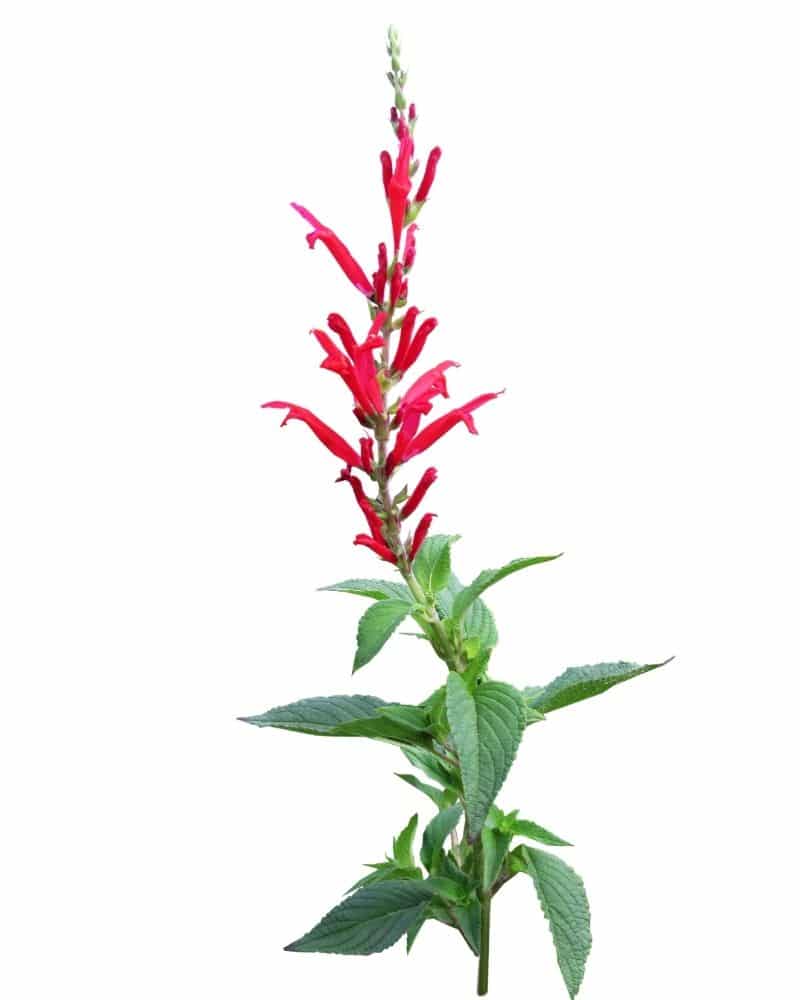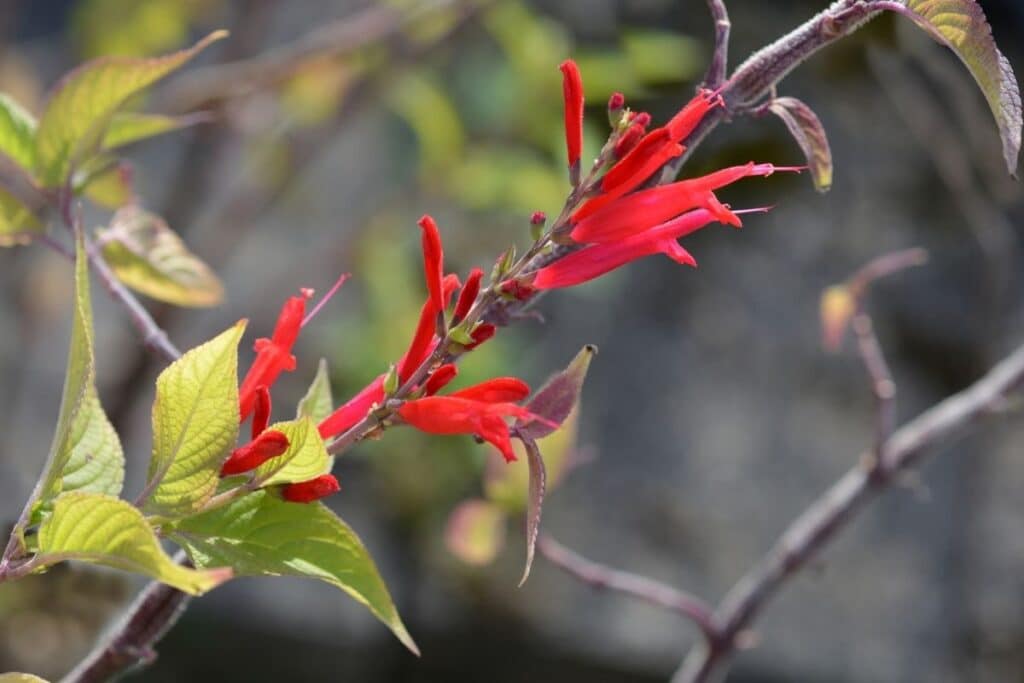Pineapple Sage is scientifically known as Salvia elegans. What’s interesting about them is that this herb releases a sweet pineapple scent through its foliage, and, what’s more, it can be used not only in the kitchen but also as a beautiful flower arrangement.
Continue reading this article to find out what other types of pineapple sage there are, plant them, and maintain them to have a massive harvesting season:
Facts about Pineapple Sage
Pineapple sage is a herb native to Central America, specifically in countries such as Guatemala and Mexico. However, nowadays, it can be easily found and cultivated throughout the world.
This herb is known as honey melon sage, pineapple scented sage, and tangerine sage; although, the pineapple sage name is the most common.
Believe it or not, this pineapple sage plant belongs to the mint family of plants called Lamiaceae, and there are over 700 species of this genus.
The pineapple sage has ruby red flowers, which are hermaphrodites; thus, they have both sexes, and, in turn, they self-pollinate themselves. They can grow up to 3 feet in height, and sometimes they will grow even more if they are left in the wilderness.
Its leaves are pale green and have an elliptical shape; its woody stems are pubescent (they are covered in small hairs that are almost invisible), and the seeds are tiny (you will need to be careful not to miss them!).
Pineapple sage is essential in any ecosystem as they attract diverse pollinators such as hummingbirds, bees, and butterflies.
Common Types of Pineapple Sage
There are several types of pineapple sage, such as:
Frieda Dixon Pineapple Sage
They have salmon-light pink flowers instead of red flowers. They are more difficult to find because they are native to Central America; they also need a warm climate in order to thrive.
Salvia elegans or Golden delicious Pineapple Sage
It is a type of pineapple sage that can grow up to 3 feet tall. It also has bright red flowers, although they seem brighter than the regular pineapple sage.
Honey Melon Pineapple Sage
It is one of the smallest pineapple sage; it has an orange and red flower, although it is not as bright as the other types. Honey melon sage will bloom earlier on in the late summer, and they require plenty of water throughout their growing stages.
Scarlet Pineapple Sage
Even though it also grows up to 3 feet in height, this pineapple sage has more prominent and more scarlet red blooms than the rest. The flowers’ color is very intense as well.
Tangerine Pineapple Sage
This variety of pineapple sage has dark red flowers but a more aromatic citrus scent. It is very similar to the more common pineapple sage, and the only difference derives from the smell it releases.
How to Grow and Care for Pineapple Sage

- It would be best if you grow pineapple sage (any variety) at the early spring. Make sure all of the frosts have already passed; if not, your plants could really suffer as they are not tolerant of cold weather.
- When planting pineapple sage, you will need to place them at least 40 inches apart. As the flowers mature, they will increase their growth rapidly, thus you will need to have plenty of space to accommodate them.
- If you have been composting throughout the year, you can add some aged compost to the soil to plant the pineapple sage. They will really appreciate this organic matter and will grow healthier.
- They will help you welcome many pollinators into your garden; this is especially good if you are growing a vegetable garden, and you need help to pollinate.
Planting Pineapple Sage

Pineapple sages should be planted during springtime, although they will take up to a year (so next year’s spring) to develop fully. They prefer natural light instead of artificial. As a result, they will only bloom if they are outdoors and receive full sun.
You should always mulch it, especially if you live in a cold climate; otherwise, the plant will not survive throughout winter. This is why pineapple sage is considered an annual plant in the Northern Hemisphere, whereas it is regarded as a perennial in the Southern Hemisphere.
In other words, if you live in a cold climate, then you must consider it as a foliage plant, which means it should be taken indoors (or you should place it in a container) before it flowers completely.
You could quickly propagate pineapple sage if you (or a friend or relative) already has one. You will need to take the roots and stems and put them in a container filled with sand, peat moss, and compost.
Soil Requirement
Pineapple sage will thrive best when it is placed in well-drained and very fertile soil. You will also need to find a place where there is plenty of morning sun.
Water Needs
They need plenty of water to survive and thrive! In fact, you will need to make sure the soil is very moist until the plant is well-rooted.
If you have planted them outdoors, they can survive on rainfall only once they are already established; if you have grown this plant indoors, you will need to irrigate the container whenever the soil is dry.
Harvesting Pineapple Sage
When the pineapple sage grows, then you can harvest the strongest or largest leaves at any time. Although, the smallest leaves will be fresher and with a more intense flavor.
You can also harvest the pineapple sage flowers (as they are edible), but you will have to eat or use them within the following two days; otherwise, they will taste bitter.
Alternatively, you can dry the pineapple sage leaves and consume them as a condiment.
Uses
You can make a pineapple sage tea with its yellow green leaves. In fact, you can put a couple of the leaves into lemonade for a lovely refreshing summer drink.
If you don’t want to consume them, but you still would like to use them, then place them in a floral container and make a bouquet. They will look amazing as an ornamental plant as well.
If you are thinking about eating them, why don’t you try making a fruit salad (with your favorite fruits) and adding some fresh flowers or pineapple sage leaves right at the end? They will give your fruit salad a new intense flavor.
FAQs
Here are some of the most frequently asked questions about pineapple sage:
What is pineapple sage good for?
Pineapple sage (Salvia elegans) is commonly used for culinary purposes, adding a sweet and fruity flavor to dishes. It is often used in teas, fruit salads, desserts, and as a garnish.
Why is it called pineapple sage?
Pineapple sage is named for its characteristic pineapple-like fragrance, which is released when the leaves are crushed or brushed against.
What does pineapple sage smell like?
Pineapple sage has a distinct sweet and fruity fragrance that resembles that of pineapples. The scent is often most pronounced when the leaves are crushed or brushed.
What is the difference between sage and pineapple sage?
The primary difference between common sage (Salvia officinalis) and pineapple sage lies in their flavors and scents. While common sage has a savory, earthy taste and aroma, pineapple sage has a sweet and fruity flavor reminiscent of pineapples, along with a corresponding fragrance. Both are members of the Salvia genus but are distinct in their culinary applications and aromatic profiles.
Conclusion
The pineapple sage scent will automatically bring you to an exotic place, no matter where you are! You may even start to think you are in a tropical area because its smell is that strong; however, it is so easy to grow than you can have it anywhere in the world!
But the pineapple sage is not only good because of its scent, but it is also good to garnish any plate or to make your drink even tastier. And if you are still unsure about how to consume it, then you can always make a tea, which will likely calm you down in no time.
Lastly, not only do they have great medicinal values, but pineapple sage herbs are so easy to plant that you can do it almost wherever you are! Have a go and plant this herb, your kitchen (and your body) will appreciate it!
If you love growing flowers, check these different types of flowers with pictures.
References
Reference List:
(1) Pereira, O. R., Catarino, M. D., Afonso, A. F., Silva, A., & Cardoso, S. M. (2018). Salvia elegans, Salvia greggii and Salvia officinalis Decoctions: Antioxidant Activities and Inhibition of Carbohydrate and Lipid Metabolic Enzymes. Molecules (Basel, Switzerland), 23(12), 3169. https://doi.org/10.3390/molecules23123169
(2) González-Cortazar, M., Maldonado-Abarca, A. M., Jiménez-Ferrer, E., Marquina, S., Ventura-Zapata, E., Zamilpa, A., Tortoriello, J., & Herrera-Ruiz, M. (2013). Isosakuranetin-5-O-rutinoside: a new flavanone with antidepressant activity isolated from Salvia elegans Vahl. Molecules (Basel, Switzerland), 18(11), 13260–13270. https://doi.org/10.3390/molecules181113260
Close
Photo by depositphotos.com/YAYImages







